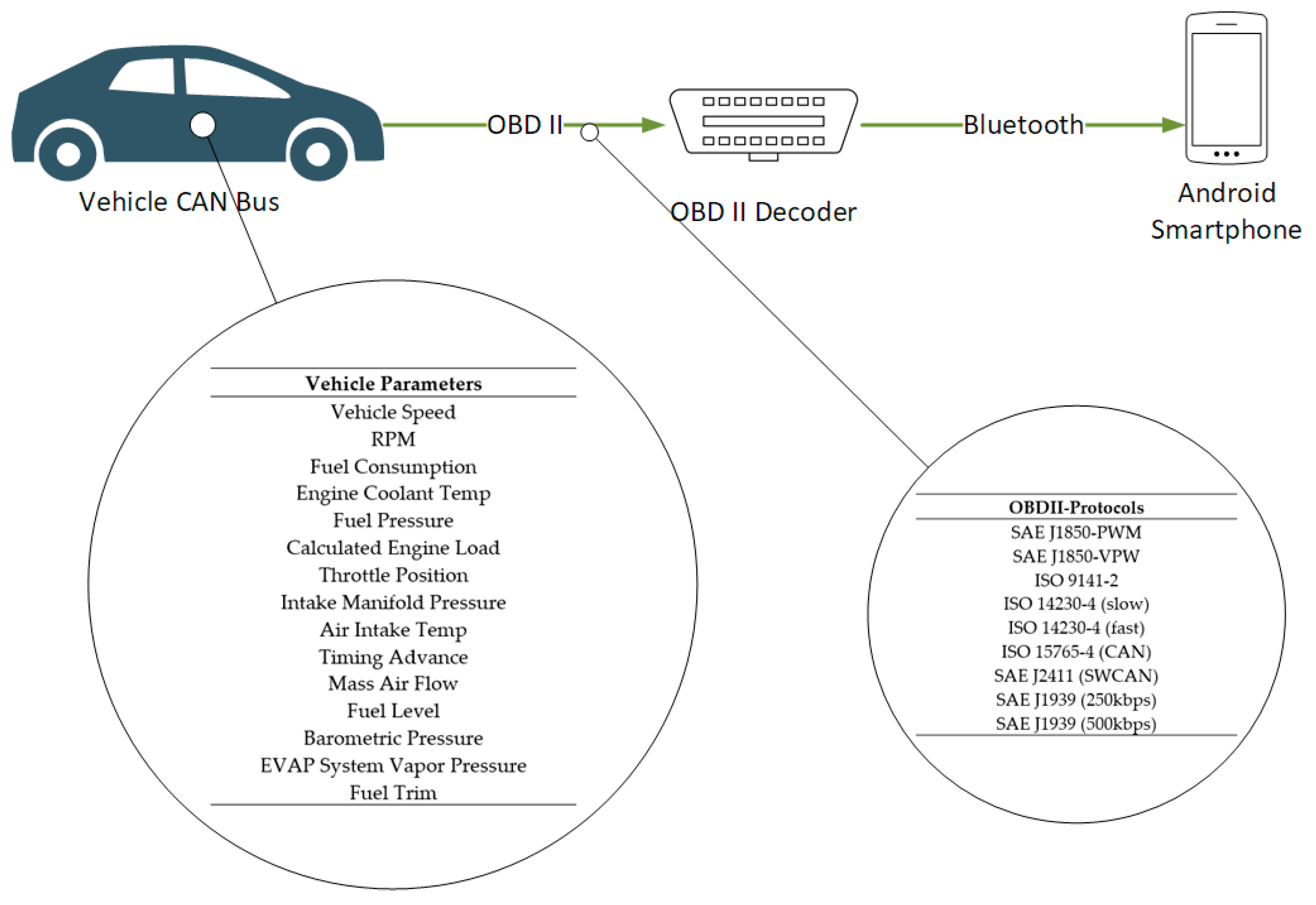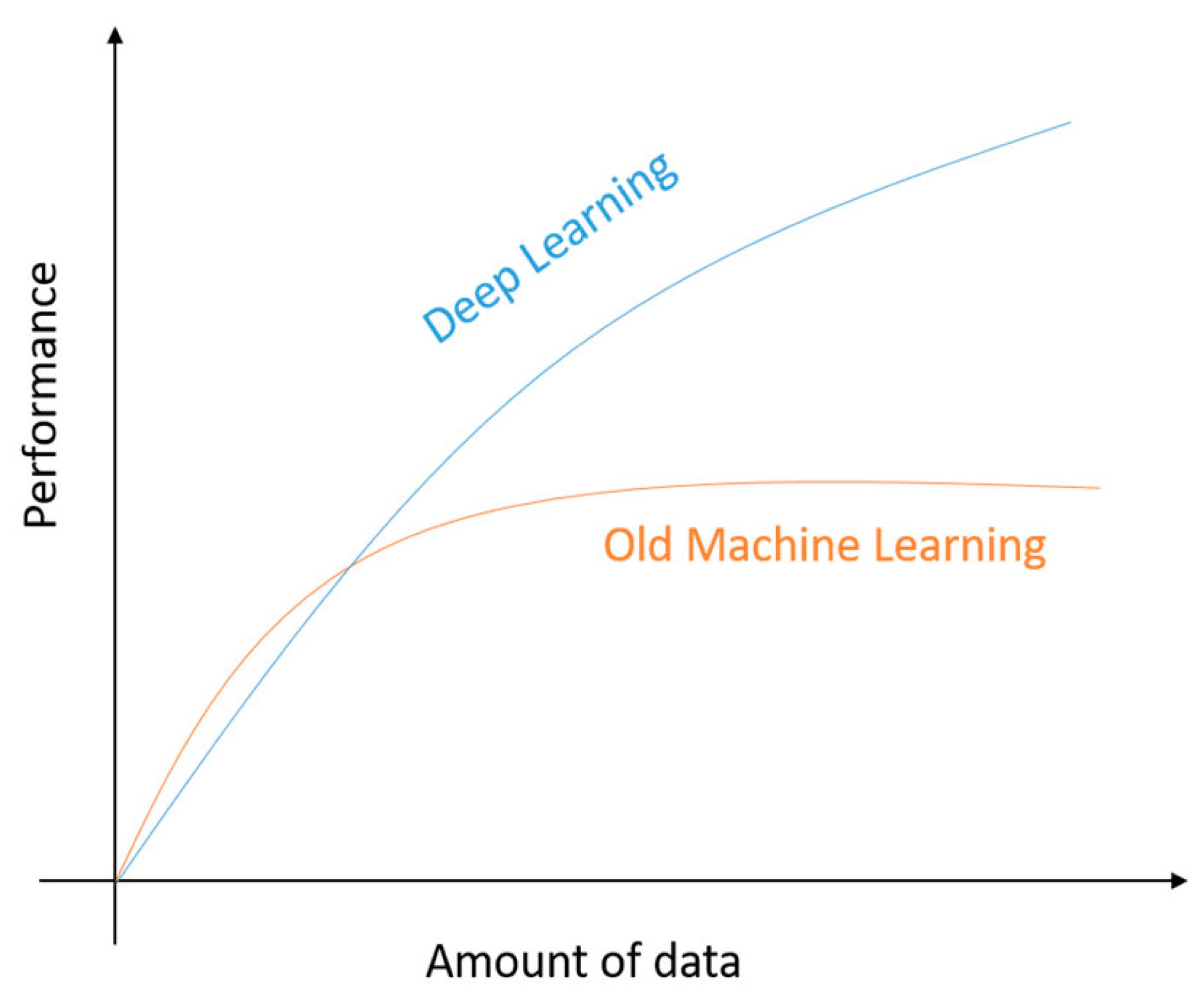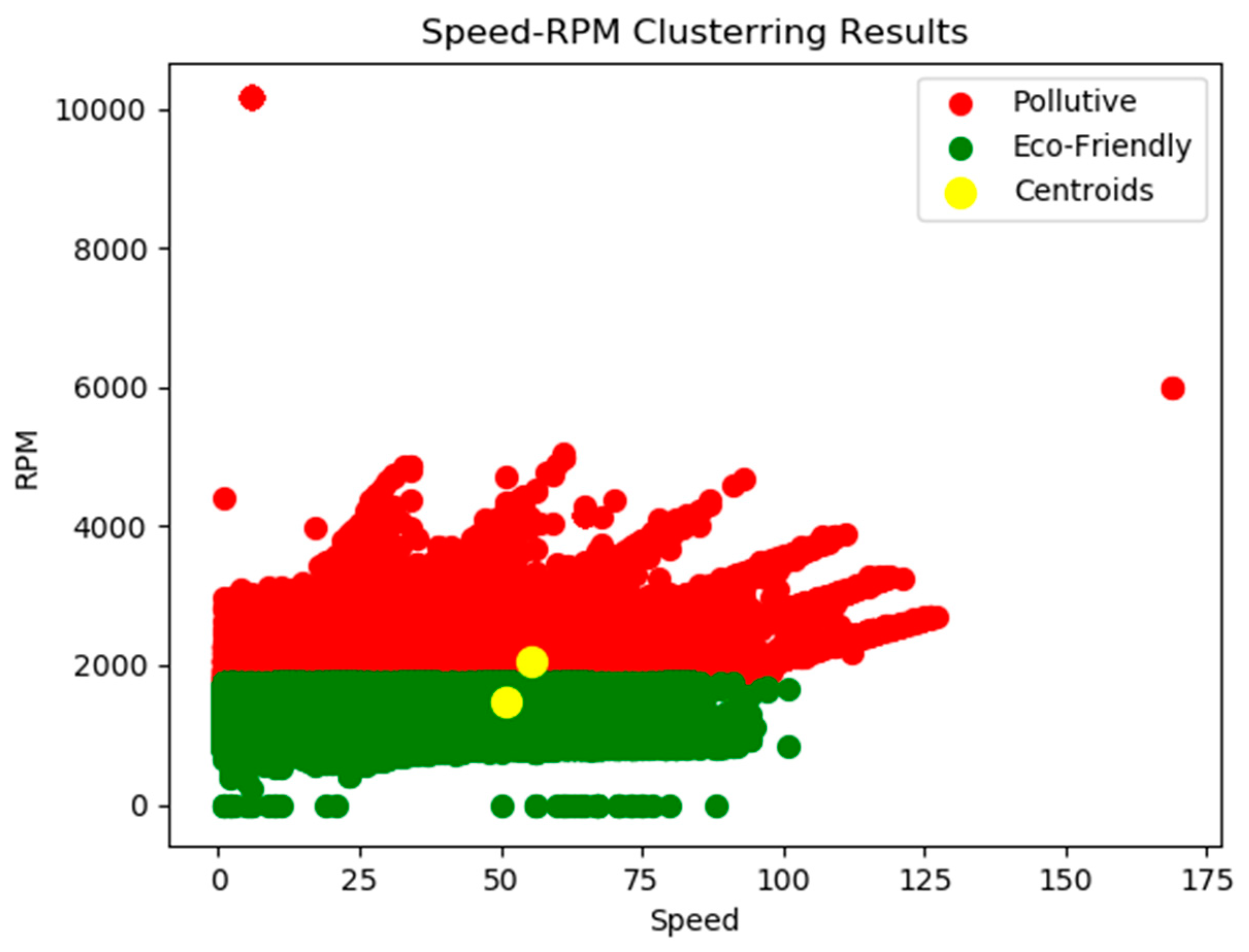Driving Behaviour Analysis Using Machine and Deep Learning Methods for Continuous Streams of Vehicular Data
Abstract
:1. Introduction
2. Related Works
3. Data Collection and Analysis Infrastructure
3.1. In-Vehicle Equipment
3.2. Cloud-Based Data Management and Analysis Platform
3.2.1. Data Streaming Module
3.2.2. Hybrid Big Data Management and Analysis Module
4. Dataset and Algorithms/Methods
4.1. Dataset Description and Data Clustering
4.2. Machine and Deep Learning Algorithms for Data Analysis
5. Results
5.1. Labelling of the Dataset via Clustering
5.2. Machine and Deep Learning Algorithms Evaluation Results
6. Conclusions and Future Work
Author Contributions
Funding
Institutional Review Board Statement
Informed Consent Statement
Data Availability Statement
Conflicts of Interest
References
- ACEA. ACEA REPORT: Vehicles in Use Europe; Vehicles in Use Europe; European Automobile Manufacturers’ Association (ACEA): Brussels, Belgium, 2021. [Google Scholar]
- World Health Organization (WHO). World Health Statistics 2020: Monitoring Health for the SDGs, Sustainable Development Goals; World Health Statistics: Geneva, Switzerland, 2020. [Google Scholar]
- European Parliament CO2 Emissions from Cars: Facts and Figures (Infographics). Available online: https://www.europarl.europa.eu/news/en/headlines/society/20190313STO31218/co2-emissions-from-cars-facts-and-figures-infographics (accessed on 5 April 2021).
- European Parliament Reducing Carbon Emissions: EU Targets and Measures. Available online: https://www.europarl.europa.eu/news/en/headlines/priorities/climate-change/20180305STO99003/reducing-carbon-emissions-eu-targets-and-measures (accessed on 5 April 2021).
- Alluhaibi, S.K.; Al-Din, M.S.N.; Moyaid, A. Driver Behavior Detection Techniques: A Survey. Int. J. Appl. Eng. Res 2018, 13, 8856–8861. [Google Scholar]
- Elassad, Z.E.A.; Mousannif, H.; Moatassime, H.A.; Karkouch, A. The Application of Machine Learning Techniques for Driving Behavior Analysis: A Conceptual Framework and a Systematic Literature Review. Eng. Appl. Artif. Intell. 2020, 87, 103312. [Google Scholar] [CrossRef]
- Araújo, R.; Igreja, Â.; de Castro, R.; Araújo, R.E. Driving Coach: A Smartphone Application to Evaluate Driving Efficient Patterns. In Proceedings of the 2012 IEEE Intelligent Vehicles Symposium, Alcalá de Henares, Spain, 3–7 June 2012; pp. 1005–1010. [Google Scholar]
- Massoud, R.; Bellotti, F.; Berta, R.; De Gloria, A.; Poslad, S. Eco-Driving Profiling and Behavioral Shifts Using IoT Vehicular Sensors Combined with Serious Games. In Proceedings of the 2019 IEEE Conference on Games (CoG), London, UK, 20–23 August 2019; pp. 1–8. [Google Scholar]
- Massoud, R. Eco-Friendly Naturalistic Vehicular Sensing and Driving Behaviour Profiling. Ph.D. Thesis, Queen Mary University of London, London, UK, 2020. [Google Scholar]
- Chen, C.; Zhao, X.; Yao, Y.; Zhang, Y.; Rong, J.; Liu, X. Driver’s Eco-Driving Behavior Evaluation Modeling Based on Driving Events. J. Adv. Transp. 2018, 2018, 9530470. [Google Scholar] [CrossRef] [Green Version]
- Jirka, S.; Remke, A.; Bröring, A. EnviroCar—Crowd Sourced Traffic and Environment Data for Sustainable Mobility. In Proceedings of the Environmental Information Systems and Services—Infrastructures and Platforms 2013—with Citizens Observatories, Linked Open Data and SEIS/SDI Best Practices, Neusiedl am See, Austria, 10 October 2013; Available online: http://ceur-ws.org/Vol-1322/paper_7.pdf (accessed on 26 April 2021).
- Delhomme, P.; Cristea, M.; Paran, F. Self-Reported Frequency and Perceived Difficulty of Adopting Eco-Friendly Driving Behavior According to Gender, Age, and Environmental Concern. Transp. Res. Part D Transp. Environ. 2013, 20, 55–58. [Google Scholar] [CrossRef]
- Castignani, G.; Frank, R.; Engel, T. Driver Behavior Profiling Using Smartphones. In Proceedings of the 16th International IEEE Conference on Intelligent Transportation Systems (ITSC 2013), The Hague, The Netherlands, 6–9 October 2013; pp. 552–557. [Google Scholar]
- Castignani, G.; Derrmann, T.; Frank, R.; Engel, T. Driver Behavior Profiling Using Smartphones: A Low-Cost Platform for Driver Monitoring. IEEE Intell. Transp. Syst. Mag. 2015, 7, 91–102. [Google Scholar] [CrossRef]
- Abdelrahman, A.; Hassanein, H.; Abu Ali, N. Data-Driven Robust Scoring Approach for Driver Profiling Applications. In Proceedings of the 2018 IEEE Global Communications Conference (GLOBECOM), Abu Dhabi, United Arab Emirates, 9–13 December 2018. [Google Scholar]
- Abdelrahman, A.; Hassanein, H.S.; Abu-Ali, N. A Cloud-Based Environment-Aware Driver Profiling Framework Using Ensemble Supervised Learning. In Proceedings of the ICC 2019—2019 IEEE International Conference on Communications (ICC), Shanghai, China, 20–24 May 2019; pp. 1–6. [Google Scholar]
- Abdelrahman, A.E.; Hassanein, H.S.; Abu-Ali, N. Robust Data-Driven Framework for Driver Behavior Profiling Using Supervised Machine Learning. IEEE Trans. Intell. Transp. Syst. 2020, 1–15. [Google Scholar] [CrossRef]
- Chen, W.-H.; Lin, Y.-C.; Chen, W.-H. Comparisons of Machine Learning Algorithms for Driving Behavior Recognition Using In-Vehicle CAN Bus Data. In Proceedings of the 2019 Joint 8th International Conference on Informatics, Electronics Vision (ICIEV) and 2019 3rd International Conference on Imaging, Vision Pattern Recognition (icIVPR), Spokane, WA, USA, 30 May–2 June 2019; pp. 268–273. [Google Scholar]
- Navneeth, S.; Prithvil, K.P.; Sri Hari, N.R.; Thushar, R.; Rajeswari, M. On-Board Diagnostics and Driver Profiling. In Proceedings of the 2020 5th International Conference on Computing, Communication and Security (ICCCS), Patna, India, 14–16 October 2020; pp. 1–6. [Google Scholar]
- Carvalho, E.; Ferreira, B.V.; Ferreira, J.; de Souza, C.; Carvalho, H.V.; Suhara, Y.; Pentland, A.S.; Pessin, G. Exploiting the Use of Recurrent Neural Networks for Driver Behavior Profiling. In Proceedings of the 2017 International Joint Conference on Neural Networks (IJCNN), Anchorage, AK, USA, 14–19 May 2017; pp. 3016–3021. [Google Scholar]
- Obuhuma, J.; Okoyo, H.; McOyowo, S. Driver Behaviour Profiling Using Dynamic Bayesian Network. Int. J. Mod. Educ. Comput. Sci. 2018, 10, 50–59. [Google Scholar] [CrossRef] [Green Version]
- Lindow, F.; Kashevnik, A. Driver Behavior Monitoring Based on Smartphone Sensor Data and Machine Learning Methods. In Proceedings of the 2019 25th Conference of Open Innovations Association (FRUCT), Helsinki, Finland, 5–8 November 2019; pp. 196–203. [Google Scholar]
- Khandakar, A.; Chowdhury, M.E.H.; Ahmed, R.; Dhib, A.; Mohammed, M.; Al-Emadi, N.A.M.A.; Michelson, D. Portable System for Monitoring and Controlling Driver Behavior and the Use of a Mobile Phone While Driving. Sensors 2019, 19, 1563. [Google Scholar] [CrossRef] [PubMed] [Green Version]
- Reininger, M.; Miller, S.; Zhuang, Y.; Cappos, J. A First Look at Vehicle Data Collection via Smartphone Sensors. In Proceedings of the 2015 IEEE Sensors Applications Symposium (SAS), Zadar, Croatia, 13–15 April 2015; pp. 1–6. [Google Scholar]
- Fugiglando, U.; Santi, P.; Milardo, S.; Abida, K.; Ratti, C. Characterizing the “Driver DNA” Through CAN Bus Data Analysis. In Proceedings of the 2nd ACM International Workshop on Smart, Autonomous, and Connected Vehicular Systems and Services; Association for Computing Machinery: New York, NY, USA, 2017; pp. 37–41. [Google Scholar]
- CUI, H. Design and Research on Automotive Controller Area Network Bus Analyzer. Sens. Transducers 2014, 166, 91–95. [Google Scholar]
- ISO ISO 11898-1:2015 2015. Available online: https://www.iso.org/standard/63648.html (accessed on 26 April 2021).
- ELM Electronics ELM327 v2.3. Available online: https://www.elmelectronics.com/ic/elm327/ (accessed on 26 April 2021).
- ELM Electronics OBD. Available online: https://www.elmelectronics.com/products/ics/obd/ (accessed on 26 April 2021).
- Professional Bluetooth Elm327 Obd2 Diagnostic Scanner For Android Windows. Available online: http://www.konnwei.com/product/420.html (accessed on 26 April 2021).
- Apache Kafka Documentation. Available online: https://kafka.apache.org/documentation/ (accessed on 27 April 2021).
- McAfee, A.; Brynjolfsson, E.; Davenport, T.H.; Patil, D.; Barton, D. Big Data: The Management Revolution. Harv. Bus. Rev. 2012, 90, 60–68. [Google Scholar] [PubMed]
- MySQL. Available online: https://www.mysql.com (accessed on 28 April 2021).
- MongoDB. Available online: https://www.mongodb.com (accessed on 28 April 2021).
- Apache Software Foundation Hadoop. Available online: https://hadoop.apache.org (accessed on 28 April 2021).
- Apache PySpark. Available online: https://spark.apache.org/docs/latest/api/python/index.html (accessed on 28 April 2021).
- Rimpas, D.; Papadakis, A.; Samarakou, M. OBD-II Sensor Diagnostics for Monitoring Vehicle Operation and Consumption. Energy Rep. 2020, 6, 55–63. [Google Scholar] [CrossRef]
- Abukhalil, T.; Al-Mahafzah, H.; Alksasbeh, M.; Alqaralleh, B. Fuel Consumption Using OBD-II and Support Vector Machine Model. J. Robot. 2020, 2020, 1–9. [Google Scholar] [CrossRef]
- Zannikos, F.; Tzirakis, E.; Stournas, S. Impact of Driving Style on Fuel Consumption and Exhaust Emissions: Defensive and Aggressive Driving Style. In Proceedings of the 10th International Conference on Environmental Science and Technology (CEST 2007), Kos island, Greece, 5–7 September 2007; Available online: https://www.researchgate.net/publication/258149928_Impact_of_driving_style_on_fuel_consumption_and_exhaust_emissions_defensive_and_aggressive_driving_style (accessed on 23 June 2021).
- Bholowalia, P.; Kumar, A. EBK-Means: A Clustering Technique Based on Elbow Method and K-Means in WSN. Int. J. Comput. Appl. 2014, 105, 17–24. [Google Scholar]
- Marutho, D.; Hendra Handaka, S.; Wijaya, E. Muljono The Determination of Cluster Number at K-Mean Using Elbow Method and Purity Evaluation on Headline News. In Proceedings of the 2018 International Seminar on Application for Technology of Information and Communication, Semarang, Indonesia, 21–22 September 2018; pp. 533–538. [Google Scholar]
- Zhang, L.; Tan, J.; Han, D.; Zhu, H. From Machine Learning to Deep Learning: Progress in Machine Intelligence for Rational Drug Discovery. Drug Discov. Today 2017, 22, 1680–1685. [Google Scholar] [CrossRef] [PubMed]
- Korotcov, A.; Tkachenko, V.; Russo, D.P.; Ekins, S. Comparison of Deep Learning With Multiple Machine Learning Methods and Metrics Using Diverse Drug Discovery Data Sets. Mol. Pharm. 2017, 14, 4462–4475. [Google Scholar] [CrossRef] [PubMed]
- Munir, M.; Chattha, M.A.; Dengel, A.; Ahmed, S. A Comparative Analysis of Traditional and Deep Learning-Based Anomaly Detection Methods for Streaming Data. In Proceedings of the 2019 18th IEEE International Conference On Machine Learning And Applications (ICMLA), Boca Raton, FL, USA, 16–19 December 2019; pp. 561–566. [Google Scholar]
- Alom, M.d.Z.; Taha, T.; Yakopcic, C.; Westberg, S.; Sidike, P.; Nasrin, M.; Hasan, M.; Essen, B.; Awwal, A.; Asari, V. A State-of-the-Art Survey on Deep Learning Theory and Architectures. Electronics 2019, 8, 292. [Google Scholar] [CrossRef] [Green Version]
- Mishra, A. Metrics to Evaluate Your Machine Learning Algorithm. Available online: https://towardsdatascience.com/metrics-to-evaluate-your-machine-learning-algorithm-f10ba6e38234 (accessed on 22 March 2021).
- Hanley, J.A.; Mcneil, B. The Meaning and Use of the Area Under a Receiver Operating Characteristic (ROC) Curve. Radiology 1982, 143, 29–36. [Google Scholar] [CrossRef] [PubMed] [Green Version]
- Pedregosa, F.; Varoquaux, G.; Gramfort, A.; Michel, V.; Thirion, B.; Grisel, O.; Blondel, M.; Prettenhofer, P.; Weiss, R.; Dubourg, V.; et al. Scikit-Learn: Machine Learning in Python. J. Mach. Learn. Res. 2011, 12, 2825–2830. [Google Scholar]
- TensorFlow Effective TensorFlow 2. Available online: https://www.tensorflow.org/guide/effective_tf2 (accessed on 4 May 2021).










| Vehicle Parameters |
|---|
| Vehicle Speed |
| RPM |
| Fuel Consumption |
| Engine Coolant Temp |
| Fuel Pressure |
| Calculated Engine Load |
| Throttle Position |
| Intake Manifold Pressure |
| Air Intake Temp |
| Timing Advance |
| Mass Air Flow |
| Fuel Level |
| Barometric Pressure |
| EVAP System Vapor Pressure |
| Fuel Trim |
| Kafka Term | Description |
|---|---|
| Topic | A group of data flows of a specific category |
| Producer | Applications which publish messages in one or more Kafka topics |
| Broker | Applications which receive and transmit a message from a producer to a consumer |
| Consumer | Applications which subscribe (read) the messages from one or more topics through the brokers |
| Feature Name | Unit of Measurement | Feature Description |
|---|---|---|
| timestamp | date & time | the timestamp of the measurement |
| lat | degrees | the latitude of the vehicle’s position |
| lon | degrees | the longitude of the vehicle’s position |
| altitude | meters | the altitude compared to sea level |
| accuracy | number | the accuracy of the vehicle’s geolocation |
| bearing | degrees | the direction of the vehicle |
| speedGPS | km/h | the speed of the vehicle according to the GPS |
| speedOBD | km/h | the speed of the vehicle |
| vinNumber | number | the unique vehicle’s identifier |
| rpm | rounds/min | the engine’ rounds per minute |
| relThrottle | percentage | the throttle’s position percentage |
| intakeTemp | °C | the environmental temperature |
| engineTemp | °C | the engine temperature |
| fuelType | list | the type of the fuel used by the vehicle |
| fuelLevel | percentage | the level of the fuel in the vehicle’s tank |
| engineRuntime | hours | the hours since the engine started |
| pendingTrouble | binary | declares if there is an emergency situation |
| carPlate | string of characters | the license plate of the car |
| Variable | Unit | Type |
|---|---|---|
| altitude | meters | integer |
| accuracy | number | double |
| bearing | degrees | double |
| speedGPS | km/h | integer |
| speedOBD | km/h | integer |
| rpm | rounds/min | integer |
| relThrottle | percentage | integer |
| intakeTemp | °C | integer |
| engineTemp | °C | integer |
| fuelType | list | integer |
| fuelLevel | percentage | integer |
| engineRuntime | hours | integer |
| Type | Algorithm Name | Parameters |
|---|---|---|
| Machine Learning | Logistic Regression | C: 1.0, penalty: ‘elasticnet’, tolerance: ‘False’, fit_intercept:‘1e-4’, class_weight: ‘balanced’, solver: ‘liblinear’, multi_class: ‘ovr’ |
| SVM (SVC) | C: 1.0, kernel: ‘linear’, degree:1, gamma: ‘scale’, class_weight: ‘balanced’, decision_function_shape: ‘ovr’ | |
| Random Forest | n_estimators: 100, criterion: ‘entropy’, max_features: ‘auto’, class_weight: ‘balanced’ | |
| Deep Learning | MLP | hidden_layers: 4, optimizer: ‘adam’, loss: ‘binary_crossentropy’, epochs: 100, batch_size: 256 |
| RNN (LSTM) | hidden_layers: 2, units: 100, optimizer: ‘adam’, loss: ‘binary_crossentropy’, epochs: 100, batch_size: 512 |
| Type | Algorithm | Training Loss | Validation Loss | Training Accuracy | Validation Accuracy | F1 Score | AUC | Precision | Recall | Execution Time (s) |
|---|---|---|---|---|---|---|---|---|---|---|
| Machine Learning | Logistic Regression | 0.018 | 0.018 | 0.982 | 0.982 | 0.977 | 0.984 | 0.966 | 0.989 | 39.706 |
| SVM (SVC) | 0.000 | 0.000 | 1.000 | 1.000 | 1.000 | 1.000 | 1.000 | 1.000 | 211.080 | |
| Random Forest | 0.000 | 0.000 | 1.000 | 1.000 | 1.000 | 1.000 | 1.000 | 1.000 | 471.997 | |
| Deep Learning | MLP | 0.006 | 0.005 | 0.997 | 0.998 | 0.998 | 0.998 | 0.998 | 0.999 | 758.756 |
| RNN (LSTM) | 0.004 | 0.002 | 0.999 | 1.000 | 1.000 | 1.000 | 1.000 | 0.999 | 17,184.356 |
Publisher’s Note: MDPI stays neutral with regard to jurisdictional claims in published maps and institutional affiliations. |
© 2021 by the authors. Licensee MDPI, Basel, Switzerland. This article is an open access article distributed under the terms and conditions of the Creative Commons Attribution (CC BY) license (https://creativecommons.org/licenses/by/4.0/).
Share and Cite
Peppes, N.; Alexakis, T.; Adamopoulou, E.; Demestichas, K. Driving Behaviour Analysis Using Machine and Deep Learning Methods for Continuous Streams of Vehicular Data. Sensors 2021, 21, 4704. https://doi.org/10.3390/s21144704
Peppes N, Alexakis T, Adamopoulou E, Demestichas K. Driving Behaviour Analysis Using Machine and Deep Learning Methods for Continuous Streams of Vehicular Data. Sensors. 2021; 21(14):4704. https://doi.org/10.3390/s21144704
Chicago/Turabian StylePeppes, Nikolaos, Theodoros Alexakis, Evgenia Adamopoulou, and Konstantinos Demestichas. 2021. "Driving Behaviour Analysis Using Machine and Deep Learning Methods for Continuous Streams of Vehicular Data" Sensors 21, no. 14: 4704. https://doi.org/10.3390/s21144704






